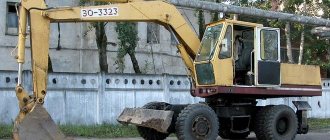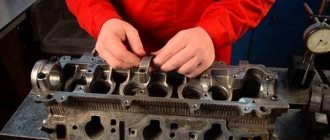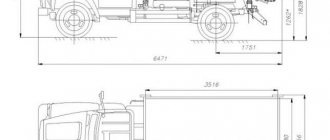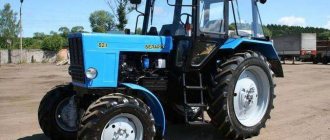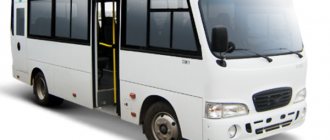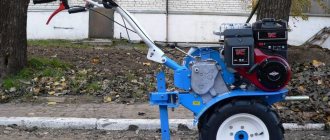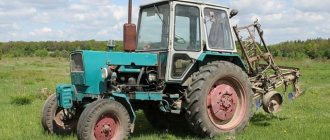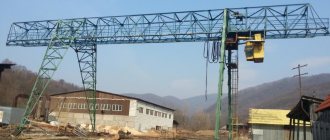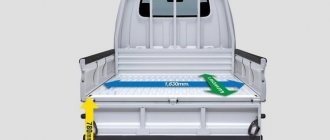Description
The weight of the ZIL 131 allows the vehicle to be classified as a truck with all-wheel drive and a front-mounted engine with a 6x6 wheel formula. The truck was originally designed as an off-road vehicle. Its task is to transport goods and people, tow trailers on any kind of soil. In the model line, this car replaced the obsolete predecessor ZIL 157.
In terms of cross-country ability, the vehicle is not inferior to many tracked competitors. The updated truck has been significantly modernized compared to its predecessor. It received an improved axle, tires with 8 layers and a special tread pattern, front-wheel drive became switchable, and a single driveshaft was installed on the transfer mechanism. The car performed excellently in difficult road and climatic conditions, operating stably and reliably in temperatures ranging from – 45 to + 55 °C.
History of creation and development
When developing the ZIL 131 car, weight and cross-country ability came to the fore. Nevertheless, the designers of the Likhachev plant successfully completed the task. The result is an inexpensive to manufacture, easy to maintain and highly unified military truck, much like its civilian counterpart under the 130 index.
It is worth noting that the version for the national economy was the first to go into production. And only three years later the army version was released. It was equipped with the appropriate components required for military specifications. However, after five years the vehicle began to be positioned as a simplified truck for civilian use. The classic 131 was mass-produced until 1986 for 20 years. Then an analogue with increased weight, the ZIL 131 N, was developed. In addition, this version received an improved engine, better efficiency parameters, a synthetic awning and modernized optics. However, this modification was not widely used, despite the fact that it was also produced at UAZ.
Device
The power unit of the car is located under the hood. The cabin is all-metal and accommodates two passengers and a driver. The driver and passengers seats are separate. The driver can adjust his seat in horizontal and vertical planes, as well as adjust the backrest tilt.
The ZIL-131 cabin was copied from the civilian 130 version - but the soldiers did not like it. After several batches were produced, it was replaced with a cabin from the ZIL-165. The car turned out to be more comfortable, the windshield became panoramic, it now consisted of two parts and provided a wide view.
ZIL-131 was similar to other domestic off-road trucks. Its main competitors were the Ural-375 and ZIL-157K. The similarity of these machines is explained by the uniform Soviet standard in force when designing such equipment. Differences could be noticed in some components and in different approaches to production.
For many years, engineers have been trying to solve a difficult problem: how to reduce the cost of a car and not lose a high level of performance characteristics? As a result, the problem was resolved, resulting in the birth of a high-quality, reliable product. After the release of the 131st, they planned to curtail the production of the 157th, however, they were produced in parallel for the next 20 years.
Exterior and cabin
Like most of their models, ZIL made the “131” model with a hooded body layout. The cabin was externally an exact copy of the 130, only mostly all samples were painted khaki.
The design also remains all-metal. Proving to be impractical, the front part was replaced, and again with a ready-made one, only now from the ZIL-165. The bent fenders and intricate grille shape were replaced with simpler but strict elements.
In the 60s of the last century, such a design was akin to revolutionary, not to mention comparing the new model with the “157” model. For almost forty years, the appearance of the military truck changed only in small details. What catches your eye most is the new windshield, which has been made panoramic.
It was not advisable to hide the engine under the cabin, since this negatively affected several factors at once: access to the engine compartment in the field worsened, and if the engine was damaged during combat operations, an increased danger was created.
Considering the focus on army needs, the appearance was similar to its other brother in the class - Ural-375. There was one country, and enterprises were completely subordinated to the state. The main differences were different solutions to technical issues and engineering structures.
The body had typical characteristics, having on board two folding benches and one removable one. The sides cannot be folded down, except for the rear one, but this does not interfere with convenient shipping and loading.
To stretch the awning, you can install special arcs. The structure of the vehicle made it possible to install other modules instead of a cargo body, such as a field kitchen, a first-aid post, a radio station, and Katyusha and S-125 missile launchers; as well as civilians - a boom with a cradle, a fire truck.
It was comfortable to be inside due to several innovations. The already mentioned windshield has significantly improved visibility compared to the previous version of the “157”. Improved thermal insulation allows you to drive the car warmly, even in winter frosts.
The driver's seat was separate from the double passenger seat and was adjustable in height, reach and backrest angle. The dashboard has a minimum number of sensors that provide the driver with all the necessary information:
- Gasoline level;
- Voltmeter/ammeter;
- Speedometer;
- Oil pressure;
- Temperature level;
- Tachometer.
Of the controls, only one is located on the steering column - the turn lever. Large mirrors provide a good view of the rear view, reducing the blind spot to a minimum, even with a trailer.
Characteristics and weight of the ZIL 131 car
Parameters of the truck in question:
- length/width/height (mm) - 7040/2500/2510;
- wheelbase (mm) - 3350/1250;
- ground clearance (under the front axle/in the area of intermediate and rear drive) (mm) - 330/355;
- wheel track front and rear (mm) - 1820;
- minimum turning radius (mm) - 1002;
- tires - 12.00/20;
- cargo platform dimensions (mm) - 3600/2320/569;
- loading height (mm) - 1430;
- weight of empty ZIL 131 (curb) (kg) - 5275 (6135);
- load capacity indicator (on highway/dirt road) (t) - 5.0/3.5;
- total weight of the truck with winch (kg) - 10425.
The load on the road from the mass of the vehicle is distributed as follows: front axle - 2750/3045 kgf, rear bogie - 3385/3330 kgf.
Power units
The serial onboard ZIL 131, the weight of which is indicated above, was equipped as standard with a four-stroke carburetor engine with 8 cylinders and a volume of 6 liters. The nominal power is 150 “horses”, the average fuel consumption is 36-39 l/100 km. The engine belongs to the overhead valve category and has liquid cooling.
In 1986, they began installing an improved power unit with a capacity of 150 horsepower on some modifications. It differed from its predecessor in the cylinder block, the heads of which received screw-type intake valves and increased compression (7.1). In addition, the engine has become more economical than its standard counterpart.
Diesels were rarely installed on this truck. For these purposes, the following types of motors were used:
- D-245.20. Engine with in-line placement of four cylinders, volume 4.75 liters. Power - 81 hp. s, fuel consumption - 18 l/100 km.
- ZIL 0550. Own-produced power unit with four strokes, volume 6.28 liters, power rating 132 hp. With.
- YaMZ-236. V-shaped engine with six cylinders, volume 11.1 liters, power 180 “horses”.
Engine
ZIL-131 is equipped with a wide range of power units. However, the most widely used versions are those with a gasoline engine, the ZIL-5081 model. This 8-cylinder, 4-stroke V-shaped carburetor unit is equipped with a “P-16B” heater, which ensures normal operation in winter. The engine is liquid cooled and lightweight.
Power plant characteristics:
- working volume – 5.97 l;
- rated power - 150 hp;
- maximum torque – 402 Nm;
- rotation speed – 3200 rpm;
- cylinder diameter – 100 mm;
- compression ratio – 6.5.
For driving in dusty areas, the engine is equipped with a special foam-oil filter with a 3-stage air purification system. A reliable, high-capacity fuel pump allows for smooth operation at high temperatures.
Frame part and suspension unit
The decent weight of the ZIL 131 vehicle required the use of a reliable and durable frame. It is made by stamping and riveting. The unit is equipped with channel-type spars connected to each other by stamped transverse ribs. There is a hook with a rubber shock-absorbing element in the rear, and a pair of rigid towing hooks in the front.
The front suspension is equipped with longitudinal springs, the front edges of which are fixed to the frame by means of fingers and “ears”. In this case, the rear ends of the knot are of the “sliding” type. The rear analogue is of a balanced configuration with a pair of longitudinal springs. The front shock absorbers are double-acting hydraulic telescopes.
Price
On the Internet you can see many advertisements for the sale of used ZIL 131 trucks of various types and purposes (flatbeds, dump trucks, fuel tankers and others). At the same time, the cost of a car can vary from 100 to 300 thousand rubles, since the technical condition of the car is different. If we talk about newer models of trucks with a diesel engine, then we are talking about prices from 500 thousand to a million rubles. ZIL 131 engines are practically not sold separately, because they are not used anywhere else.
Steering and brakes
The truck in question is equipped with a power steering system, placed in a common compartment with a control mechanism. The last element is a working pair with a screw and a nut on hinges, as well as a rack with gearing. The hydraulic booster pump is a plate type and is driven into rotation by the crankshaft pulley belt. Longitudinal-transverse rods - with heads on ball elements, are equipped with self-clamping crackers.
The truck's brakes are drum brakes with a pair of internal pads. The parts are released using a cam mechanism located on all wheels. The diameter of the drum is 42 centimeters, the width of the pads is 10 cm. When the brake system is activated, the pneumatics are activated, without axial separation. The parking block is mounted on the transmission shaft, also of the drum type. The braking distance at a speed of 60 km/h is approximately 25 meters.
Transmission unit
Knowing the weight of the ZIL-131, you need to understand the type of system that controls the movement of such a large vehicle. The truck in question is equipped with a manual transmission with five modes. The block circuit includes a pair of inertial synchronizers. The transfer case is also mechanical, with a cardan transmission in an open configuration.
A dry single-plate clutch is combined with a spring type damper of rotational vibrations. The element is located on the driven disk. The number of rubbing pairs is two, the friction linings are made of asbestos composition. Some car models are equipped with a winch, an additional worm gear, and the cable length is 65 meters.
Specifications
The ZIL-131 engine is very similar to its older “relative” 157. The technical features of the 131st engine have become significantly better, the power is much greater, and the design problems of the previous system have been taken into account and corrected.
So, among the basic and most significant technical parameters, it is worth highlighting the following:
- The total engine capacity is 6 liters or 5969 cubic centimeters.
- Configuration - V8.
- Engine arrangement of in-line and longitudinal type.
- Fuel consumption is approximately 59.5 liters per 100 kilometers.
- The ZIL-131 engine has 8 cylinders that operate in this order: 1-5-4-2-6-3-7-8.
- The system is equipped with 16 valves.
- The diameter of the piston system is 100 millimeters.
- The ZIL-131 engine is cooled by liquid.
- The power structure of the machine is carburetor.
- The total weight of the ZIL-131 engine is 490 kilograms.
Absolutely all ZIL 131 engines are equipped with a 5-speed manual gearbox. The transfer case has a two-stage structure.
Cabin and body
The cabin of the truck in question is of an all-metal configuration, with three seats and additional thermal insulation. The unit is heated using a liquid method, from the motor cooling system with a centrifugal fan. The heater is controlled using a special damper on the cab panel. Ventilation is provided by roll-down windows, rotating windows and a channel in the right wing mudguard. The seats inside are separate, the driver's seat is adjustable, the cushions are made of a sponge rubber compound.
The body of the ZIL 131 car is a wooden platform with a metal edging and transverse base beams. Of all the sides, only the rear element is folding. The cargo platform is designed to transport people. The side compartments have folding benches for 16 seats. In addition, there is an additional eight-seater bench located in the middle part of the body. The protective awning is installed on removable arches.
Loading platform
The car body consists of a wooden platform with a metal frame and metal cross bars. The design is complemented by solid front and side sides. The rear platform was equipped with a folding side.
The standard ZIL 131 body is designed for wide use. In addition to transporting any cargo, the platform can also serve to transport people. To achieve this, the platform was equipped with folding benches, providing 16 seats, and an additional middle removable one, which can accommodate 8 people.
Peculiarities
Based on the universal chassis of the specified truck, various modifications of special vehicles were produced. Among them:
- Fire trucks.
- Fuel trucks and fuel tankers.
- Oil refillers.
- Tank trucks.
- Airfield tractors with increased weight.
For military laboratories, workshops, radio stations, and headquarters versions, standard universal, sealed bodies were used. They were equipped with special filtration systems that take air masses from outside and supply them to the van, while simultaneously disinfecting the interior.
KUNG from ZIL 131, dimensions and weight:
- length - 4.8 m;
- height - 1.95 m;
- width - 2.2 m;
- weight (dry/curb) - 1.5/1.8 t.
KUNG and other modifications
The truck model in question turned out to be so successful that a large number of different modifications were produced on its basis.
ZIL-131 KUNG is especially popular. This abbreviation stands for “uniform body of zero overall size.”
Its frame is made of angles and channels of various sizes, sheathed on top with metal sheets.
Find out the technical characteristics of the Ural 375 engine in our article. And here we consider the Grunwald tipper, tilt and semi-trailer container carriers.
The inside of this ZIL-131 van body is lined with foam plastic or other heat-insulating material, after which everything is covered with antiseptic-coated plywood, which improves the technical characteristics of the entire vehicle.
Regardless of their purpose, all KUNG trucks in question are equipped with:
- heating;
- ventilation;
- all kinds of household equipment;
- lighting system (plafonds on the ceiling).
The uniqueness of the ZIL-131 KUNG was the presence in its body of a special filtration unit FVUA-100N-12.
It took air from the environment and disinfected it. Overpressure was created, which made it possible to protect the space inside the van.
The heating system was completely autonomous; heat was generated by burning diesel fuel.
Also, based on the truck in question, the following modifications with good technical characteristics were made:
- ZIL-131NA was equipped with leaky and unshielded equipment;
- ZIL-131V – truck tractor;
- ATZ-3 and similar ones were used as fuel tankers;
- MZ-131 – oil tankers;
- ATs-40 – fire engine.
Even after the production of this truck was officially stopped, it still continued to be produced with similar tactical and technical characteristics, but as AMUR-521320.
Bottom line
As many years of practice have shown, the ZIL 131 has proven itself to be a reliable, durable and easy-to-maintain truck. Its main advantage is its high cross-country ability, which guarantees passage with a full load of washed-out and clayey areas. An additional bonus is the presence of a reduction gear, and mechanical tire inflation allows you to adjust the tire pressure, depending on the road surface and axle load.
In addition, drivers note a relatively comfortable cabin and easy access to main parts, which increases the machine’s maintainability. Despite the fact that the serial production of this vehicle was completed many years ago, it can still be found in various sectors of the economy.
Reviews from owners and drivers
- I have a ZIL 131 - an updated 130 with a medium axle. The car impresses with cross-country ability and copes with the assigned tasks. My car is used as a timber carrier, as well as technical assistance. This is an army heavy truck with military camouflage. Honor and praise to those car enthusiasts who convert these cars into mobile bathhouses, although this is purely business. The car is more power hungry than the 130th model. This modification has an extended side platform and so-called “conics”. ZIL 131 copes well with the duties of a log carrier with an average load capacity of 5 tons. In addition, this model has proven itself well as a timber truck. Of course, the cost of owning such a car costs a tidy sum, but this, of course, is not compared with foreign analogues). The machine has a high degree of survivability and maintainability. The interior has a “Spartan” seating position, so you can immediately see that this is a pure workhorse. The 6.0 liter engine produces 150 hp. With. and consumes at least 30 liters at 60 km/h.
- An excellent rogue as the main source of income. When I was very young in the era of the USSR, my father’s ZIL-131 seemed quite huge to me, but in theory it is a medium-tonnage truck, and in the 131 version it also has increased cross-country ability. The 6.0 liter engine regularly produces 150 horses and is prone to overheating. In winter, it pleases with a confident start. The presence of three bridges is impressive in terms of cross-country ability - the car confidently moves through swampy areas. The tread of the tires is, to put it mildly, not shabby. And yet, there are also force majeure situations: once we got stuck in a deep river - we drove there specifically to wash the truck. But alas, we didn’t notice - the car was sucked into this abyss much deeper. Fortunately, we had a winch then. Otherwise, this heavy ZIL would hardly have left without outside help. The fuel consumption of this middle-class “tractor” is 35-40 liters, depending on the load. The carburetor is powerful enough for such a weight of car.
- I am the owner of a ZIL-131 truck, which has a set of disadvantages and advantages, like any other truck for comparable money. Yes, it has a gigantic consumption of 40 liters. And this car is also poorly suited for long-distance travel. But the driving performance of the 131 is excellent. It's nice to meet this "old guy" in the village, in the city, at a construction site, in a quarry, etc. I use it for off-road driving, as a towing vehicle, etc. The ZIL 131 must be admitted as a worthy investment if you need a stable source of income. Of course, you need your own auto repair shop, since third-party maintenance of the ZIL will cost serious money. ZIL has a durable engine that can work in hot or cold weather. The transmission shifts predictably and doesn't overheat. As far as I remember, a similar combination (ICE + manual transmission) from ZIL was installed on the famous Lviv LAZ bus. The engine consumes a lot of gasoline and oil, which can be considered its main disadvantage.
- I work on a ZIL 131 manufactured in 1984. I must admit, this car is a legend of the Soviet automobile industry, because thanks to such cars it was possible to rebuild an entire large country. Like a great power, ZIL also has many disadvantages, but there are many more advantages! In terms of dynamics, the car pulls well even uphill or on a country road, as well as in muddy ground. But you need to understand that the higher the load, the greater the fuel consumption. I fit in 40-45 liters depending on the load. But how ZIL overcomes mud barriers cannot even be described in poetry. You can drive in reverse uphill - however, to do this you need to lower the tire pressure to 0.5. It is noteworthy that on the highway you can squeeze out as much as 70 km/h from this hard worker. The car drives easily, given the large traction reserve. Perhaps the only thing better than this car is the GAZ-66.
- I have a Soviet-made ZIL 131. Equipped with a 6-liter gasoline engine and manual transmission. It’s a pity, such a car is very difficult to find in diesel version - with this engine ZIL is much more economical. But the 6-liter gasoline engine impresses with its acceleration dynamics. The car is capable of confidently crossing a deep ford, unless the Urals passes in front of it - you yourself understand how deep the ruts are from its wheels. It is precisely for such cases that the modification with a winch came in handy. I would like to note the convenient operation of the transmission and transfer case. The brakes are pneumatic. We were pleased with the very strong axles - in fact, this is a real cargo-class SUV. However, the consumption of 40-45 liters does not correspond to current standards. Unfortunately, a diesel option could not be found.
- Once I was lucky enough to drive this truck - to earn extra money on vacation, so to speak. I have the 131st ZIL with a D-245 engine running on heavy fuel. This unit is perfect for a truck and heavy vehicle with fancy off-road capabilities. Reliability, reliability and maintainability are the main advantages of this vehicle with timely maintenance. The diesel engine has a large reserve of thrust at low speeds. obstacles can be overcome without acceleration. The truck doesn’t care about hills, ditches, foxes or swamps. The car is equipped with a centralized tire inflation system, which allows you to deflate the tires at the right time and thereby turn the ZIL into a kind of tracked vehicle. This feature, as well as the 6x6 wheel formula, easily compensate for the lack of inter-wheel locks. If necessary, the front axle can be disabled. There is a power take-off drive, as well as an 80-meter winch. With such an off-road arsenal, of course, it would be a sin to hope for good driving performance in urban conditions. The car rolls heavily and is almost uncontrollable. The steering wheel is very heavy, the truck is clumsy. The roar of the engine in the cabin makes the voice of the passenger almost inaudible. There is yaw, and already at medium speed. However, the braking system is worth praising – by class standards, of course. It must be admitted that nothing can replace the ZIL 131 where the road ends and Russian land begins.
- This truck is worth the money spent. I have a version with a 6.0 liter engine, which is considered the most controversial for this model. Okay, there it shows itself quite well on the 130th model, but the 131st ZIL with such an internal combustion engine consumes even more fuel and oil. Of course, this is due to the 6x6 wheel arrangement and more toothy tires - almost like the Ural. At least these “slippers” are installed on my modification. Fortunately, the car is so repairable that it is not a problem to even replace the engine - there are heaps of them in stock. I had a case where I was sent on a flight, there were a couple of kilometers left to the final point, but suddenly the engine suddenly stalled. I thought the carburetor had failed - it wouldn’t pick up speed and generally wouldn’t start. After being driven to the base, the engine was opened and shavings were found, as well as a flying corkscrew ring. The main journal and engine were ground down for replacement, fortunately we have several of them. But this time they installed a diesel engine - it is much more economical.

